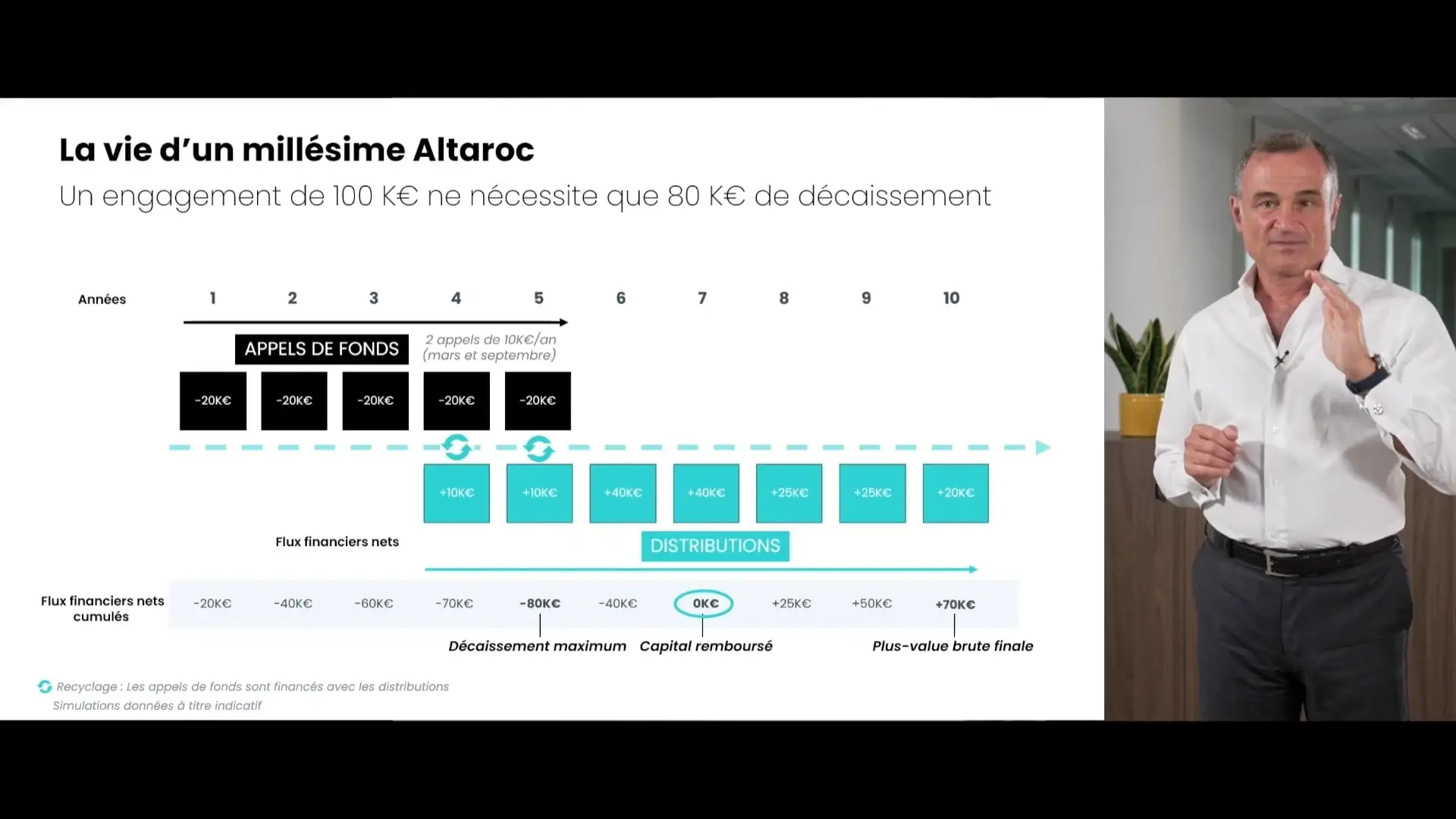A review of Altaroc’s “Basic Building Block”
Summary
Written transcription
Frédéric Stolar: Before talking about Re-Up, let's have a quick look at Altaroc. It's very important because it's the basic molecule. So what does Vintage Altaroc get you? For 80%, it gives you access to 6 exceptional funds, 5 or 6 of the world's leading funds in the top quartile, with a fantastic track record that you wouldn't be able to access on your own. 20% of the portfolio is made up of co-investments, with no fees or carried charges, made exclusively alongside the managers we have selected. This lowers our fees and enables us to fine-tune our Vintage drawdowns. Altaroc is also about reliable cash flow, which is a fundamental point. We'll come back to this later. The Altaroc molecule, Vintage Altaroc . Its cash flow is very stable, whereas a private equity fund's drawdown is uncertain. The speed of deployment is uncertain on Vintage Altaroc because it is averaged. With six managers, you have a very stable cash flow model. Altaroc Another key factor is the programmed calls for funds. This is fundamental. We've set up a subscription system. As you'll recall, 20% per year, 10% on March 30, 10% on September 30. So we have perfect, simple visibility on the date and quantum of calls for funds. And last but not least Altaroc, Vintage are manufactured by our plants every year. With the certainty that Vintage will be manufactured every year, it is possible to build products and multi-millimeter programs based on our basic annual bricks and seasons.
Frédéric Stolar: So now, in terms of cash flow, what does the life of a Vintage Altaroc mean? How does it work? You know this slide perfectly well. Our call for funds over the first five years is a subscription of 20% a year for five years, and here we've modeled the fairly compact distributions of a Vintage Altaroc . The Vintage distributes 10% a year from the fourth year onwards, 10% a year in year 4, 40% a year in year 5, 6% in year 6 and 7% in year 7. Your capital is back at the end of the year. Seven 10, 10, 40, 40 makes 100 and you recover 25, 25 and 20 over years 8-9 ten. So what does that mean in cash terms? And here I'm going to introduce a new concept that we haven't really talked about in the past, and that's the concept of recycling. In theory, you're called on for €100,000 over the first five years. But what we see here is that in years 4 and 5, you will receive €10,000 per year, in years 4 and 5. You'll be able to use this €10,000 to finance part of the €20,000. So the reality is that in year four, you won't really be drawing €20,000, you'll only be drawing €20,000 minus €10,000 of distribution. In other words, you'll only net €10,000.
Frédéric Stolar: The same for you in year five. So in fact, at the end of year five, you'll only be drawing €80,000 and not net and not €100,000. So that means that in year seven, you've recouped your stake. Nothing has changed, and in years 8-9 ten, well, in the basic model we gave you, you'd get back €170,000 for €100,000 committed. The same thing is going to happen, except that of the €170,000, we used €20,000 to finance calls for funds. So you're only going to get back €150,000 because we only drew down €80,000. Your capital gain is the difference between 150 and 80. You have €70,0.00 of capital gain in what we presented to you before. You had 170 of distribution. In a conservative case, on 100 of commitment, here you have 150 of net distribution on 80 of net drawdown. It's the same way of presenting the figures, but it's a slightly different way of thinking. We're no longer thinking in terms of maximum engagement, but in terms of actual circulation. So it's the same two sides of the same coin. Now let's take a look at a curve. This is the famous cash flow curve of a Vintage Altaroc . You know it by heart. Except that before, we had explained to you that it goes down to €100,000 in a somewhat conceptual model, and goes up to €170,000 of distribution.
Frédéric Stolar: If we now think in net terms, you're not being drawn at €100,000. On a net basis, you're being drawn at €80,000, and we won't be distributing €170,000; we'll only be distributing €170,000 less the €20,000 used to finance recycling. So you'll receive €150,000. In other words, when you've drawn down to €80,000, at the end of year 7 you'll be reimbursed for the €80,000, so that at the end of year 7 you'll have recovered your investment, and you'll have €70,000 in additional distributions between years 8, 9 and 10. In the end, what will your multiple be on the capital drawn down? And we haven't changed anything compared to Altaroc. You will no longer make 1.7 times the committed capital, but 1.88 times the drawn capital, i.e. 150 divided by 80: 1.88 on the drawn capital. So there are two ways of looking at Altaroc : 1.7 on the commitment in terms of a multiple of the bet, or 1.8 on the max cash drawn. It's the same way of presenting things, but perhaps the way of reasoning in terms of a multiple on capital at work is the simplest way of presenting it. So that's for the basic molecule Altaroc with reliable and simplified cash flows on the basic brick Altaroc.






